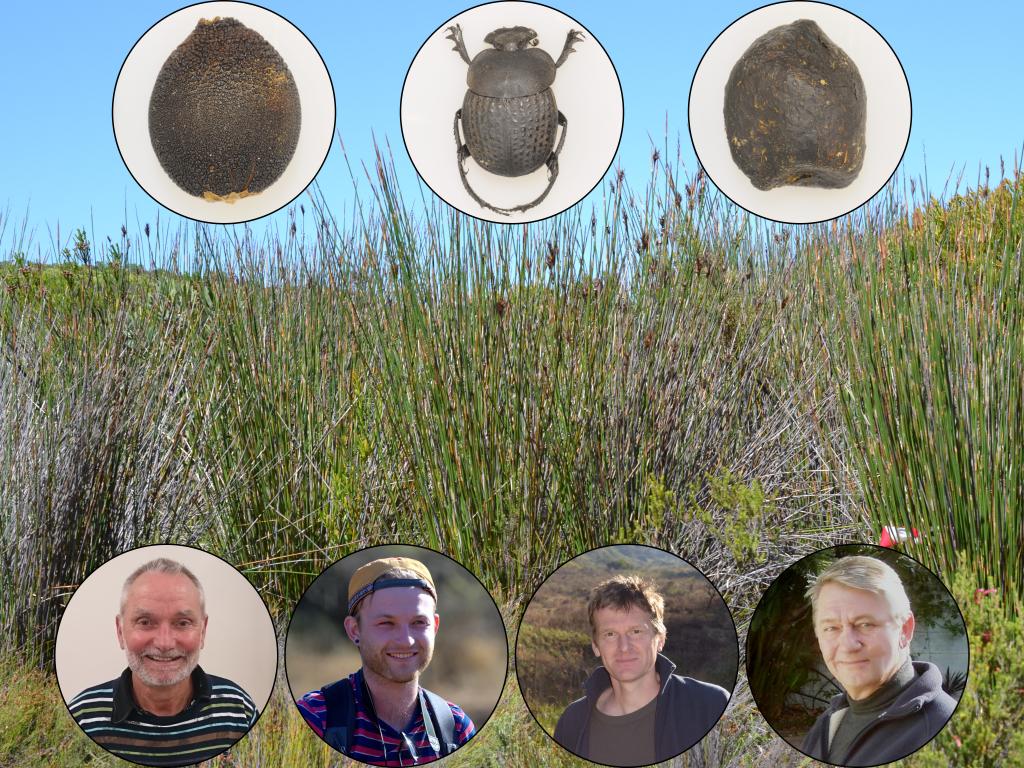Dung hits UCT headlines again


Ceratocaryum argenteum in the background with seed dung beetle and pellet and Jeremy Midgley, Joseph White, Steve Johnson and Gary Bronner
View a video of the plants tricking the dung beetle here
The Cape Restio Ceratocaryum argenteum produces large hard nuts that are buried by dung beetles. These nuts smell like dung but provide no food for dung beetles or their larvae - a classic example of biological deception. These are the surprising findings of a paper just published by biologists from UCT and UKZN in the prestigious journal Nature Plants.
Deception is a very interesting biological phenomenon as it involves a co-evolutionary arms race between one species (the deceiver or mimic) that benefits from resembling another species (the dupe or model) with no advantages, and sometimes even fitness costs, for the latter. Some of the most striking examples of deception in plants involve deceiving insects to pollinate flowers without any rewards. Some orchids, for example, produce colourful flowers containing no nectar to reward pollinating insects. These plants rely on sensory exploitation (insects are attracted to colour in general), and in some extreme cases mimic other rewarding plants that occur at the same locality, thereby duping insects to pollinate their nectarless flowers.
Deception for seed dispersal, however, is far less common. Some plants produce hard red or black seeds (such as the so-called lucky beans) that look like berries, but these do not seem to fool birds and are hardly ever eaten or dispersed. Also, such seeds are often poisonous and their bright colours are therefore more of a warning colouration than an attraction to fruit-eating birds. Dung beetles being duped into dispersing “dung-like” Ceratocaryum nuts may therefore be the best example globally of faecal mimicry for seed dispersal. The scent of Ceratocaryum nuts is very strong. “I have 9 month old seeds in a paper bag in my office that are still very pungent”, says Jeremy Midgley, a Professor in the Biological Sciences Department at UCT. Steve Johnson, a Professor at UKZN who did the chemical analyses for this study, was amazed at both the complexity of scents emitted by Ceratocaryum seeds and their similarities to antelope dung. “It still remains to be seen exactly which chemical is the most attractive to the dung beetles" says Steve Johnson.
“I have had a long interest in seed burial by certain Cape rodent species and was convinced that the enormous size of Ceratocaryum seeds would make them attractive to rodents, either to immediately eat them or to bury them” said Jeremy Midgley. He, together with M. Sc student Joseph White and UCT small mammal expert Dr Gary Bronner, investigated if free-ranging small mammals were interested in Ceratocaryum nuts “We used motion-sensing trail cameras to observe small mammal interactions with the nuts under field conditions, and it seemed that they were either disinterested or even repelled by the seeds. When they cracked open seeds it was clear small mammals were interested in the nutritious inner parts of the seeds” recollects Joe White. “We suspect that the smell of the nuts repels small mammals, although Nature Plants made us delete this part of the paper because the data were not strong enough. In future we will put an extract of these seeds on palatable seeds and see whether this causes small mammals to lose interest in these seeds” adds Jeremy Midgley.
The most surprising result from their field experiments was the discovery of dung beetles dispersing Ceratocaryum nuts. “Through both camera trapping and direct observation, we saw dung beetles being attracted to the nuts, rolling them away and then burying them by pulling them down from below.” comments Gary Bronner, recalling that “previously we observed the same behaviour by another dung beetle species in the Cedarberg where Ceratocaryum plants do not occur, suggesting that this phenomenon may be quite general and widespread in fynbos. “I wonder what would happen if we put these nuts out in the savanna” ponders Jeremy Midgley, “would they fool savanna dung beetles?”
Dung beetles do inadvertently disperse some seeds., for instance those already in dung of fruit-eating mammals that they bury to nourish their offspring. However, this is not deception as the beetles gain a reward. With Ceratocaryum nuts, however, dung beetles are duped into dispersing and burying nuts with no reward but with energetic costs. It is likely this type of dispersal is quite rare because it depends on the right ratio of dung and dung beetles. “Too much dung and the nuts will not be buried because beetles have too much of a choice, too little dung and there will be a similar lack of burial owing to too few dung beetles – we still have much to learn about the dynamics of such faecal mimicry” concludes Jeremy Midgley
